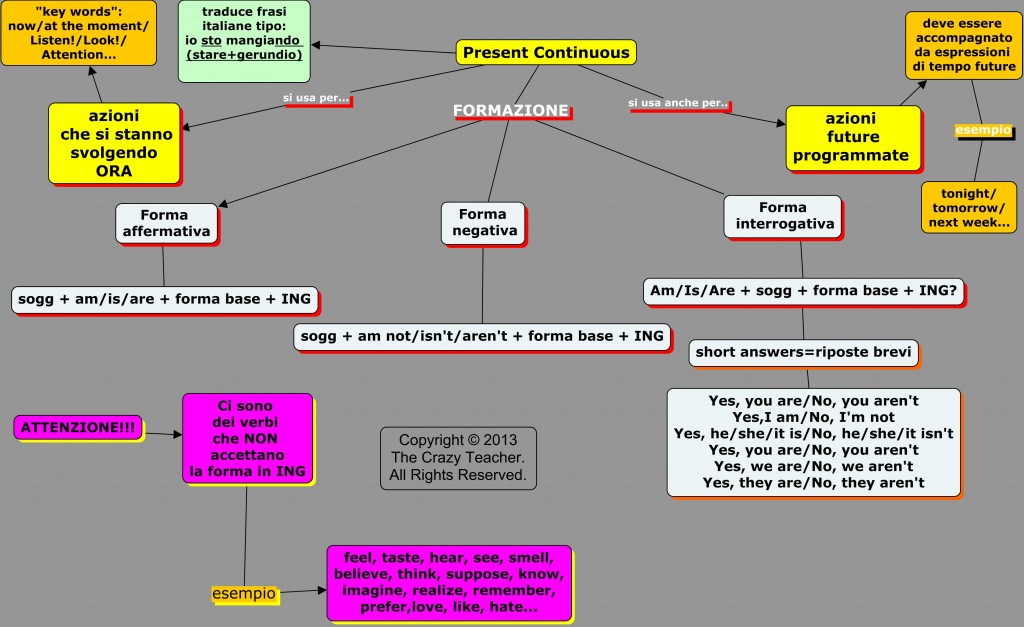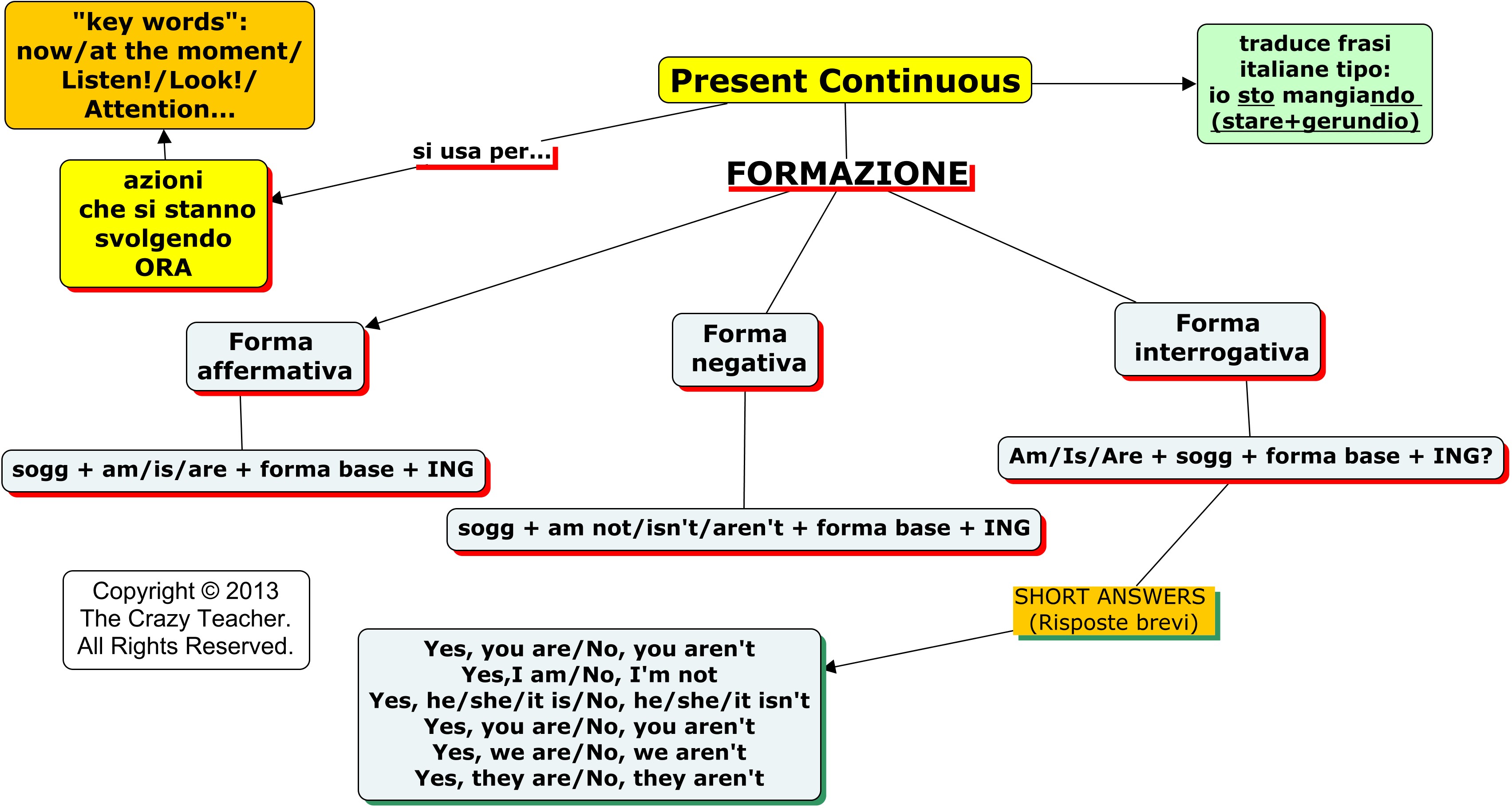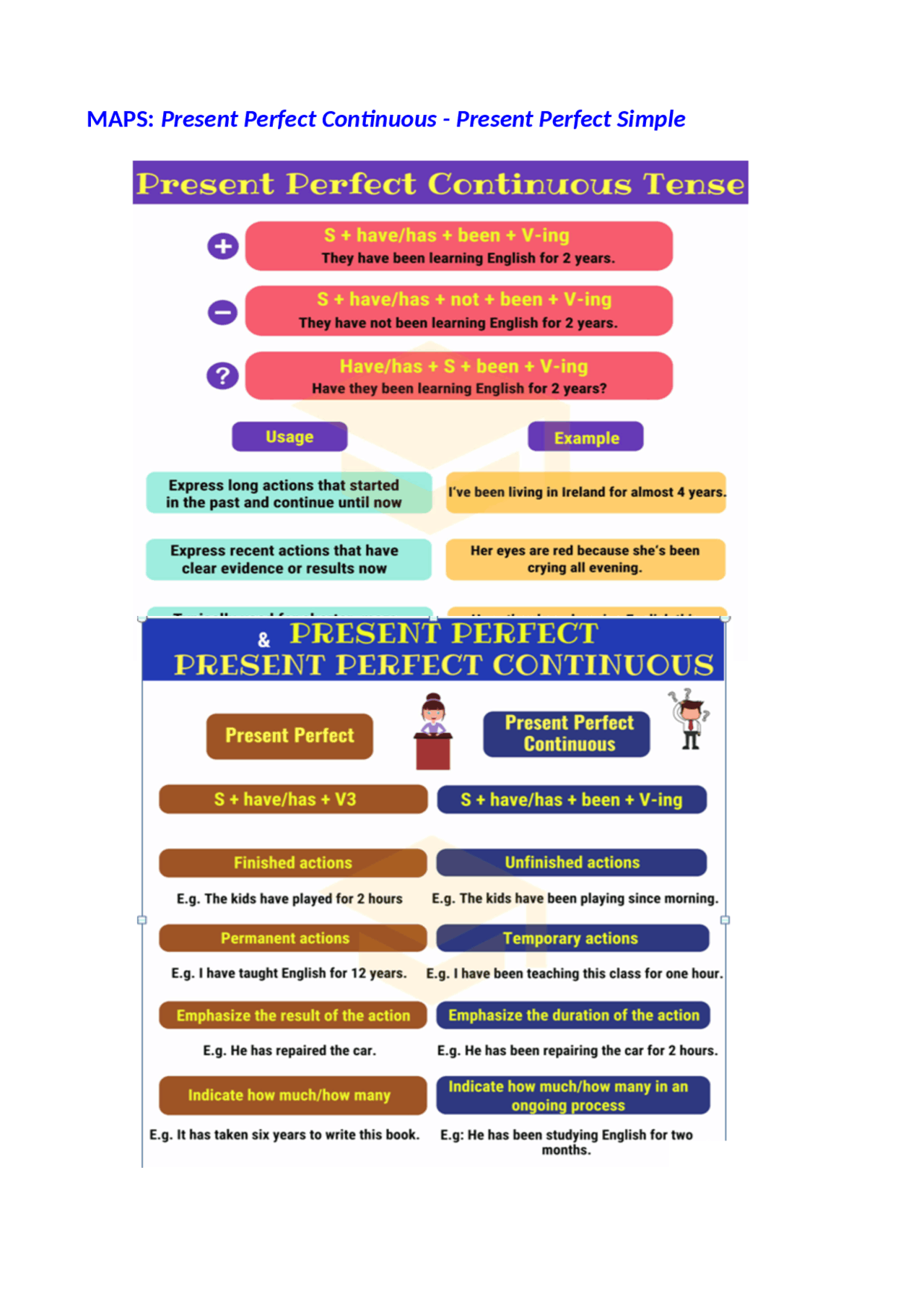
mappa schema tabella dsa futuri inglese will going to present
Forming the present continuous The present continuous of any verb is composed of two parts - the present tense of the verb to be + the present participle of the main verb. (The form of the present participle is: base+ing, e.g. talking, playing, moving, smiling)

Present Continuous The crazy teacher's blog The crazy teacher's blog
15 Maggio 2021 Questo sito usa Akismet per ridurre lo spam. Scopri come i tuoi dati vengono elaborati. Ecco due mappe riassuntive e schematiche per capire questo tempo verbale inglese. Vedremo quando si usa e come si forma al presente.

Can I help you? Archivi Pagina 2 di 42 The crazy teacher's blog The
The auxiliary verb (be) is conjugated in the Present Simple: am, are, is The main verb is invariable in present participle form: -ing For negative sentences we insert not between the auxiliary verb and the main verb.. For question sentences, we exchange the subject and the auxiliary verb.. Look at these example sentences with the Present Continuous tense:

MAPPE per la SCUOLA PRESENT CONTINUOUS
Alternatively, consider sending the video link to your learners for a "flipped" class or for remote learning. Grammar Worksheet. Present Continuous. Use the 'ing' form of the verbs to describe. the picture. Answer Key on Page 2. Level: Beginner to Elementary. Time: Approx 10 minutes.

Mappa concettuale present simplecontinuous Teacher R PRESENT SIMPLE
Like we already discussed, the present continuous is a very useful tense for natural-sounding conversations with English speakers. In fact, we use it daily and it has a number of different uses. Another reason to learn it is that, if you want to know all the English tenses, the present continuous is a great place to start.

Present Simple Mappa Concettuale
Another way you can use the present continuous is to talk about new behavioural patterns or habits, such as in the following cases: "She's not answering her emails lately." "He's calling his mom a lot these days." "They're spending a lot of time together." "We're getting along very well recently." (note: time words and phrases such as "these.

Pin by Make M on English grammar Present continuous tense, Learn
Present perfect continuous Past continuous Past perfect simple Present perfect simple Past perfect continuous was / were + -ing for: • background information and actions in progress at a particular time in the past: What were you doing at 6 a.m. this morning? • two actions happening at the same time : 3. had + Past participle for:

Present simple or present continuous Mappa Lingua Inglese Studocu
The present continuous, also known as the present progressive tense, refers to actions that are taking place now, these days, or nowadays. Here, the action hasn't been completed yet. It is continuing and will do so for a little while. Sentence example. For example: She is cleaning the house.

Present Simple Mappa Concettuale
The present continuous (present progressive) tense is a way to convey any action or condition that is happening right now, frequently, and may be ongoing. It adds energy and action to writing, and its effect helps readers understand when the action is happening.

PRESENT CONTINUOUS Mappa e riassunto
Il Present Continuous è una forma verbale che viene utilizzata per descrivere le azioni che sono in corso di svolgimento o che stanno per svolgersi. Questa forma verbale è composta dal verbo essere seguito dalla forma in -ing del verbo principale.

Present Perfect Continuous Simple Inglese Docsity
The present continuous (also called the present progressive) is a verb tense used to refer to a temporary action that is currently taking place. It can also describe future plans (e.g., "I am throwing a party next week").

Present Continuous The crazy teacher's blog The crazy teacher's blog
Release time:2023-01-20. Here we have a mind map illustrating the English grammar of the present continuous tense. As illustrated in the present continuous tense mind map, the present continuous tense consists of a form of the auxiliary verb "to be" plus an active verb in the present participle form. It is used to depict an action that is.

Pin su Mappe, schemi, semplificazioni
The present continuous tense, as the name suggests, is the form of tense that is used to denote an action that is ongoing or occurring in that current moment. It is also referred to as the present progressive tense as they represent the action that is progressing in the present.

Verbo Present continuous Mappa concettuale
Mappa concettuale sul PRESENT CONTINUOUS - Inglese Il Present Continuous o Present Progressive, in inglese, si usa per descrivere azioni in corso di svolgimento o azioni temporanee. Mappe in PDF Mappe per esame Didattica in gioco Campi educativi PRESENT CONTINUOUS

IL PRESENT CONTINUOUS
When a change is noticeable, the present continuous tense is used to give this observation. 3. Represents temporary events. Change happens over time. So when there's a new trend or behavior, the present continuous tense describes that occurrence. 4. Expresses new patterns or habitual actions. 5.

PRESENT PERFECT
We also use the present continuous to talk about: something which is happening before and after a specific time: At eight o'clock we are usually having breakfast. When I get home the children are doing their homework. something which we think is temporary: Michael is at university. He's studying history.